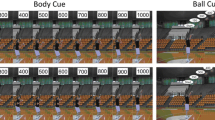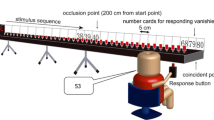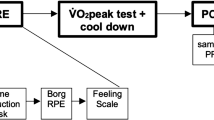Abstract
Humans’ time evaluation within the range of hundreds of milliseconds is often distorted, and time is judged as much longer than actually is. This consistent overestimation has been interpreted as an indicator of the threshold level for the sensitivity of the perceptuomotor system. The purpose of this study was to investigate how the perception of time, both in sub- and supra-second timescales, changes for elite athletes that are considered as individuals with highly developed motor perceptual capabilities and with great sense of time particularly for the extremely short timescales. For this purpose, we asked elite pole-vaulters to reproduce the exposure times of a familiar image showing a pole-vault jump and non-familiar images as a fencing lunge and scrambled pixels and compared their estimates with controls. While the time distortion in the supra-second range was similar for athletes and controls independently from the image presented, in the sub-second range of time, athletes were more accurate and less variable than controls, while for all the participants, the images were perceived differently. Time was perceived as shorter when viewing the pole-vault jump image followed by the fencing lunge and last the scrambled pixels, providing the evidence that action observation distorts individuals’ time perception by compressing the perceived passage of time. Remarkably though pole-vaulters’ higher precision and lower variability than controls indicate their ability to compensate for this distortion due to a well-refined internal clock developed through sport training.




Similar content being viewed by others
References
Aglioti SM, Cesari P, Romani M, Urgesi C (2008) Action anticipation and motor resonance in elite basketball players. Nat Neurosci 11(9):1109–1116
Bakker M, de Lange FP, Stevens JA, Toni I, Bloem BR (2007) Motor imagery of gait: a quantitative approach. Exp Brain Res 179(3):497–504. doi:10.1007/s00221-006-0807-x
Bootsma RJ, Van Wieringen PC (1990) Timing an attacking forehand drive in table tennis. J Exp Psychol Human 16(1):21–29
Brown SW (1995) Time, change, and motion: the effects of stimulus movement on temporal perception. Percept Psychophys 57(1):105–116
Brown SW, West AN (1990) Multiple timing and the allocation of attention. Acta Psychol 75:103–121
Brown SW, Stubbs DA, West AN (1992) Attention, multiple timing, and psychophysical scaling of temporal judgments. In: Macar F, Pouthas V, Friedman WJ (eds) Time, action, and cognition: towards bridging the gap. Kluwer Academic Publishers, Dordrecht, pp 129–140
Buhusi CV, Meck WH (2005) What makes us tick? Functional and neural mechanisms of interval timing. Nat Rev Neurosci 6(10):755–765
Chen Y-H, Pizzolato F, Cesari P (2013) Observing Expertise-Related Actions Leads to Perfect Time Flow estimations. PLoS ONE 8(2):e55294. doi:10.1371/journal.pone.0055294
Cicchini GM, Arrighi R, Cecchetti L, Giusti M, Burr DC (2012) Optimal Encoding of Interval Timing in Expert percussionists. J Neurosci 32:1056–1060
Coull JT, Vidal F, Nazarian B, Macar F (2004) Functional anatomy of the attentional modulation of time estimation. Science 303:1506–1508
Eagleman DM (2008) Human time perception and its illusions. Curr Opin Neurobiol 18(2):131–136
Felz DL, Landers DM (2007) The effect of mental practice on motor skill learning and performance: a meta analysis. In: Smith D, Bar-Eli M (eds) Essential reading in sport exercise psychology. Human Kinetics, Champaign IL, pp 219–231
Grondin S (2010) Timing and time perception: a review of recent behavioral and neuroscience findings and theoretical direction. Atten Percept Psychophys 72:561–582
Guillot A, Collet C (2005) Duration of mentally simulated movement: a Review. J Mot Behav 37(1):11–20
Hancock PA, Block RA (2012) The psychology of time: a view backward and forward. Am J Psychol 125:267–274
Jacini WF, Cannonieri GC, Fernandes PT, Bonilha L, Cendes F et al (2009) Can exercise shape your brain? Cortical differences associated with judo practice. J Sci Med Sport 12:688–690
Lewis PA, Miall RC (2003) Distinct systems for automatic and cognitively controlled time measurement: evidence from neuroimaging. Curr Opin Chem Biol 13(2):250–255
Moscatelli A, Polito L, Lacquaniti F (2011) Time perception of action photographs is more precise than that of still photographs. Exp Brain Res 210(1):25–32. doi:10.1007/s00221-011-2598-y
Nather FC, Bueno JLO (2011) Static images with different induced intensities of human body movements affect subjective time. Percept Motor Skill 113(1):157–170. doi:10.2466/24.25.27.PMS.113.4.157-170
Nather FC, Bueno JLO, Bigand E, Droit-Volet S (2011) Time changes with the embodiment of another’s body posture. PLoS ONE 6(5):e19818. doi:10.1371/journal.pone.0019818
Rammsayer TH (1999) Neuropharmacological evidence for different timing mechanisms in humans. Q J Exp Psychol 52(3):273–286
Rivero TS, Covre P, Reyes MB, Bueno OFA (2013) Effects of chronic video game use on time perception: differences between sub- and multi-second intervals. Cyberpsychol Behav Soc Netw 16(2):140–144. doi:10.1089/cyber.2012.0103
Wearden JH (2003) Applying the scalar timing model to human time psychology: progress and challenges. In: Helfrich H (ed) Time and mind II: information-processing perspectives. Hogrefe and Huber, Gottingen, pp 21–39
Wearden JH, Lejeune H (2008) Scalar properties in human timing: conformity and violations. Q J Exp Psychol 61(4):569–587
Wei G, Zhang Y, Jiang T, Luo J (2011) Increased cortical thickness in sports experts: a comparison of diving players with the controls. PLoS ONE 6(2):e17112. doi:10.1371/journal.pone.0017112
Author information
Authors and Affiliations
Corresponding author
Rights and permissions
About this article
Cite this article
Chen, YH., Pizzolato, F. & Cesari, P. Time flies when we view a sport action. Exp Brain Res 232, 629–635 (2014). https://doi.org/10.1007/s00221-013-3771-2
Received:
Accepted:
Published:
Issue Date:
DOI: https://doi.org/10.1007/s00221-013-3771-2




